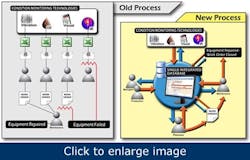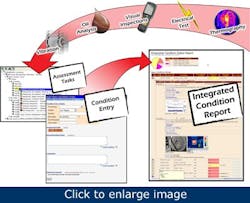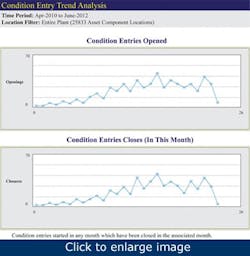Alcoa Warrick Operations Smelter, a fully operating smelter in the United States, recently increased its use of predictive maintenance (PdM) as part of its larger Reliability Excellence (REX) program. REX is an Alcoa (www.alcoa.com) corporate initiative designed to reduce maintenance costs and achieve sustainable performance levels.
Figure 1. Alcoa’s Warrick site in Evansville, Indiana, was founded in 1960 and has an annual capacity of 269,000 metric tons.
Site-wide, there are more than 1,950 total Warrick Operations employees. The Evansville, Indiana, primary metals business includes five smelter potlines with a capacity of 269,000 metric tons per year, which supply molten aluminum to a rolling and finishing operation that supplies flat-rolled aluminum for use in food and beverage cans. The plant also provides metal for the lithographic printing industry. (Figure 1)
The need for centralized PdM information tracking
One area that needed improvement was the tracking of PdM information. Identified defects would, at times, fall through the cracks, and equipment would run to failure before repair. Smelter Engineering Manager Joseph Motz, CMRP, tasked reliability engineers and technicians with finding a better way to track information and create a cradle-to-grave system. “Defects must be tracked from the time they are found to the time they are proven to be fixed. Losing information halfway is unacceptable,” says Motz.
The process for tracking PdM information at Warrick had been less than optimal and did not provide feedback to technicians on defect correction progress. “Our predictive maintenance technicians would perform their work, send out reports, and then rarely ever hear anything back. They didn’t know if their work had changed anything for the better,” says Reliability Coordinator Josh Estep, CMRP. “Unfortunately, the only feedback that they would consistently receive was when equipment would fail unexpectedly. For predictive maintenance technicians, it is devastating to find that the underlying risk had been discovered and reported prior to the machine failing in service.”
Because their findings and recommendations were sent without feedback, visibility, or accountability, the predictive maintenance technicians never learned if the problem was fully remedied or if the root cause was repetitive in nature. The plant’s predictive maintenance team was eager to have a more meaningful role in the equation.
Without a centralized system, reports and information coming from different monitoring technologies were at risk of being lost and forgotten until failures occurred.
“Electrical reports were sent to an email distribution list, after which the planner was responsible for writing a work order and scheduling repairs,” explains Estep. “On the mechanical side, we used an Excel spreadsheet to log machine conditions and findings. The file was sent out once a month to an email distribution list, after which the planner became responsible for generating and tracking the work.
“The electrical program lacked a reporting tool to summarize and prioritize the work, and, while the mechanical program had these capabilities, it failed to provide timely feedback on equipment conditions,” says Estep. “Furthermore, both systems had a flaw in the lack of a closed-loop reporting system where machine defects stay in the system until proven through data that they are fixed. We needed this cradle-to-grave, closed-loop reporting to improve machine reliability.”
A new, centralized reliability tracking system was needed to automate the processes. The preferred system would increase employee engagement and satisfaction while achieving economic and regulatory goals, as well as contribute to the overall success of REX (Figure 2).
Figure 2. A new, centralized reliability tracking system was needed to automate the processes.
Web-based communications and handheld devices for tracking routes and capturing data would simplify the predictive process and encourage comprehensive recordkeeping. For instance, trend values such as temperature or current could be logged on handheld devices rather than tracked on paper. Captured data could include thermographic inspection results, including which equipment is down and what isn’t loaded or can’t be inspected. In lubrication rounds, technicians could enter whether an asset was greased, in addition to the amount of grease used. Housekeeping observations processed on the fly might include a machine making noise or leaking oil or an area of the plant requiring cleaning.
Critical choice
Alcoa Warrick Operations began using 24/7 Systems’ Web-based program called Tango in 2001 for the tracking of high-criticality AC induction motors. The asset-based tracking system helps the smelter to keep track of failure data and repairs, along with helping to locate suitable replacements. In 2008, when a better defect tracking system was being pursued for predictive maintenance, it was determined that Tango software made the most financial sense for the smelter. The system was already in place and there was already a history of cooperation between 24/7 Systems and Alcoa, not to mention it was a fraction of the cost of going with the other potential solutions.
Alcoa had been one of 24/7 Systems’ first customers when it purchased Tango Reliability Information Management for electric motor management in 2001. The solution was initially hosted on the plant’s own servers but eventually the smelter adopted the vendor’s subscription-based, secure Web-hosted offering. Turning over responsibility for the information technology to 24/7 Systems, including the software, servers, backups and security, allowed the plant’s IT team to focus on other priorities.
The successful motor management foundation led Warrick Smelter to implement the full suite of solutions, including Equipment Management, Condition Management, Repair Tracker, Roundslogger, Oilography, and Tango Mobile.
Reliability information
In 2008, Condition Management and Repair Tracker modules were added to track predictive anomalies and repair results, allowing Alcoa to further prevent failures in service and identify the root causes of failure. Motor repair shops like Flanders Electric (www.flanderselectric.com) are able to enter repair data in the hosted system using a simplified, secured repair shop portal, rather than having to go through Alcoa’s firewall. All repair vendors are required to use the system as part of their contracts because it allows Alcoa to verify that the contracted tasks are performed at the designated intervals and to track the results and findings.
The 2009 deployment of Roundslogger took visual inspection rounds from notepads to handheld electronic PDAs, with automated alarms as the inspection data is collected. Within the past year, Oilography, which simplifies systematic oil sample scheduling and analysis, and Tango Mobile, which allows users to access the system anywhere in the plant from a wireless handheld device, were added to modernize previously manual tasks.
Warrick Smelter’s work processes were modified to maximize the new solution, using a multi-pronged approach to predictive maintenance including motor management, lubrication management, ultrasound inspections, vibration analysis, and infrared inspections.
Qualitative and quantitative
The Web-based reliability information management solution helped Warrick Smelter to accomplish its goal of cradle-to-grave reporting, thus eliminating manual spreadsheets and report distribution processes. Technicians, maintenance planners, and managers can all see the status of equipment condition problems and interact with each other through their Web browsers or smartphones. As a result, reliability technicians are more actively involved the equipment lifecycle. With the closed-loop process, they can see how their information is used and whether it prevents a failure or corrects a problem, rather than being passive purveyors of problem reports.
The cradle-to-grave reporting through Tango software had an unforeseen benefit as it relates to employee engagement. Tango allows the predictive technicians to see the progress of their work when they receive an automatically generated email saying that work has been performed to correct the defect they found. After doing a recheck, the technician gets further positive reinforcement when clicking on a button that says, “closed,” which means not only was the defect found, but something was done about it. In a single click, the technician sees the significance of the work.
Maintenance planners, who are vital to the successful implementation of Tango, are also beneficiaries of the new solution. Prioritization is easier with reports that show all anomalies in a specified area sorted by defect severity, equipment criticality, age of anomaly, or other preferred criteria. With this information, a planner is not left to determine what should be worked on first. If the system is set up with an accurate asset criticality and the defect severity levels are reasonable, the system will naturally point planners to the defects that can cause the greatest financial harm to operations. In essence, the defects should show up in order of greatest cost avoidance. The system is also useful for providing lists of defects that can be repaired during a scheduled outage (Figure 3).
Figure 3. Prioritization is easier with reports that show all anomalies in a specified area sorted by defect severity, equipment criticality, age of anomaly, or other preferred criteria.
The financial benefits of implementing Tango are included with all the cost savings programs implemented through REX. “Warrick Smelting’s REX program has been credited with a 36% reduction in R&M costs,” says Warrick Smelter ABS Manager Mark Keneipp, CMRP. The overall program is also credited with increasing the plant’s predictive hour percentage by approximately 12%, increasing area overall equipment effectiveness by more than 20%, and producing an estimated 60% reduction in annual motor repair and replacement costs (Figure 4).
Figure 4. The overall program is also credited with increasing area overall equipment effectiveness by more than 20%.
“The ultimate goal of predictive maintenance is not to find problems early, but to run plant assets at the lowest possible cost over their lives as to best improve the financial position of the company. Predictive maintenance must save money; otherwise, the only thing being predicted is failure,” says Estep. Predictive maintenance supports Alcoa’s ability to be financially competitive by giving maintenance personnel time to plan and schedule repairs in an efficient manner, which costs approximately 15% as much as an unplanned failure. This cost reduction directly impacts the smelter’s cost per metric ton.
The link
It is imperative that a link exists between Alcoa’s Tango software and its computerized maintenance management system (CMMS), says Maintenance Planning Coordinator Larry McCubbins, CMRP. “The link is accomplished by making sure that the assets in Tango have the same name as the assets in our CMMS. We link the two systems together via a work order that is created in the CMMS and then entered in Tango on the anomaly.”
[pullquote]The Tango automatic email system greatly aids the planner in addressing the anomaly, explains McCubbins. Based on the criticality of the anomaly and the criticality of the equipment, the planner works through any issues to get the repairs scheduled. The work order, along with the Tango data about the anomaly, gets distributed to the crafts making the repairs. The crafts will send the work ticket with comments about the repair back through the maintenance supervisor and then to the planner. The planner will schedule any follow-up work required or go into Tango to check off the anomaly, which sends an automatic email to the reliability technician to follow up to make sure the repair was successful. If the anomaly is at a high risk of failure, the planning process is bypassed and the emergency repair process is implemented, after which the anomaly is checked off in Tango and the reliability technician is notified to follow up.
“It is now an integral part of our organization’s culture to have condition-based anomaly prediction driving our maintenance schedules,” says McCubbins. “Now, we are addressing the problems before they reach failure, and we are saving thousands of dollars through improved equipment reliability. As a result, we have the time to schedule and plan the repair instead of us getting scheduled by the repair.”
Look forward
The new reliability capabilities will soon be enhanced by upgraded handheld devices. “Warrick Smelter is excited about new opportunities to utilize technological developments such as smartphones and tablets to increase information transfer, elevate productivity, and reduce costs,” says Estep. “I personally can see these new technologies changing the way maintenance is performed industry-wide.”
The Alcoa employees are likely to embrace this change, as well, because it will further enhance communication and increase visibility into how their own actions have direct, positive consequences on critical equipment reliability, as well as the organization’s overall competitiveness.
As Warrick Smelter’s experience has shown, tools that empower maintenance employees with greater involvement and ownership are likely to improve morale and effectiveness, promote enthusiasm about the new processes, and reward the plant through lower costs, increased reliability, and greater employee satisfaction.




